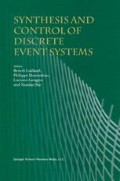Abstract
Liveness-enforcing supervision of sequential resource allocation systems is currently a well-defined problem, underlying the operation of many contemporary technological systems, spanning a wide spectrum of applications. This technical note provides a brief overview of the currently available results, delineating, both, our major analytical understandings/characterizations concerning the problem concepts/structure and its complexity, and also, our ability to synthesize effective and computationally tractable solutions to it. The last part of the document identifies open/unaddressed research issues, the resolution of which will extent the power of the current theory and will allow the integration of the developed results in the broader control frameworks managing the behavior of these environments.
This work has been partially supported by NSF grant ECS-9979693
Access this chapter
Tax calculation will be finalised at checkout
Purchases are for personal use only
Preview
Unable to display preview. Download preview PDF.
References
Araki, T., Sugiyama, Y., and Kasami, T. (1977). Complexity of the deadlock avoidance problem. In 2nd IBM Symp. on Mathematical Foundations of Computer Science,pages 229–257. IBM.
Banaszak, Z. A. and Krogh, B. H. (1990). Deadlock avoidance in flexible manufacturing systems with concurrently competing process flows. IEEE Trans. on Robotics and Automation, 6: 724–734.
Cassandras, C. G. and Lafortune, S. (1999). Introduction to Discrete Event Systems. Klumwer Academic Pub., Boston, MA.
Chu, F. and Xie, X.-L. (1997). Deadlock analysis of petri nets using siphons and mathematical programming. IEEE Trans. on R&A, 13: 793–804.
Desel, J. and Esparza, J. (1995). Free Choice Petri Nets. Cambridge Univerrsity Press.
Ezpeleta, J., Colom, J. M., and Martinez, J. (1995). A petri net based deadlock prevention policy for flexible manufacturing systems. IEEE Trans. on R&A, 11: 173–184.
Fanti, M. P., Maione, B., Mascolo, S., and Turchiano, B. (1997). Event-based feedback control for deadlock avoidance in flexible production systems. IEEE Trans. on Robotics and Automation, 13: 347–363.
Fanti, M. P., Maione, B., and Turchiano, B. (1998). Deadlock avoidance in cellular manufacturing systems. In Proceedings of the 1998 IEEE Conference on Systems, Man and Cybernetics,pages 588–593. IEEE.
Gold, E. M. (1978). Deadlock prediction: Easy and difficult cases. SIAM Journal of Computing, 7: 320–336.
Kumar, R. and Garg, V. (1995). Modeling and Control of Logical Discrete Event Systems. Kluwer Academic, Pub., Boston, MA.
Lawley, M., Reveliotis, S., and Ferreira, P. (1997). Design guidelines for deadlock handling strategies in flexible manufacturing systems. Intl. Jrnl. of Flexible Manufacturing Systems, 9: 5–29.
Lawley, M., Reveliotis, S., and Ferreira, P. (1998a). The application and evaluation of banker’s algorithm for deadlock-free buffer space allocation in flexible manufacturing systems. Intl. Jrnl. of Flexible Manufacturing Systems, 10: 73–100.
Lawley, M., Reveliotis, S., and Ferreira, P. (1998b). A correct and scalable deadlock avoidance policy for flexible manufacturing systems. IEEE Trans. on Robotics & Automation, 14: 796–809.
Lawley, M. A. and Reveliotis, S. A. (2001). Deadlock avoidance for sequential resource allocation systems: hard and easy cases. Intl. Jrnl of FMS (to appear).
Lin, F. (1993). Robust and adaptive supervisory control of discrete event systems. IEEE Trans. Autom. Control, 38: 1848–1852.
Park, J. and Reveliotis, S. (2000a). Algebraic synthesis of efficient deadlock avoidance policies for sequential resource allocation systems. IEEE Trans. on R&A, 16: 190–195.
Park, J. and Reveliotis, S. (2001a). Algebraic deadlock avoidance policies for conjunctive/disjunctive resource allocation systems. In Proc. of ICRA’01. IEEE.
Park, J. and Reveliotis, S. A. (2000b). Liveness-enforcing supervisors for resource allocation systems with reworks, forbidden states, and uncontrollable events. Technical Report (sumbitted to IEEE Trans. on R&A), ISyE, Georgia Tech.
Park, J. and Reveliotis, S. A. (2001b). Deadlock avoidance in sequential resource allocation systems with multiple resource acquisitions and flexible routings. IEEE Trans. on Automatic Control (to appear), 46.
Park, J. and Reveliotis, S. A. (2001c). Policy mixtures: A novel approach for enhancing the operational flexibility of resource allocation systems with alternate routings. Technical Report (sumbitted to IEEE Trans. on R&A), ISyE, Georgia Tech.
Park, J., Reveliotis, S. A., Bodner, D., and McGinnis, L. (2001). A distributed event-driven control architecture for flexibly automated manufacturing systems. Intl. Jrnl on CIM (to appear).
Ramadge, P. J. G. and Wonham, W. M. (1989). The control of discrete event systems. Proceedings of the IEEE, 77: 81–98.
Reveliotis, S. A. (1999). Accommodating fms operational contingencies through routing flexibility. IEEE Trans. on R&A, 15: 3–19.
Reveliotis, S. A. (2000). Conflict resolution in agv systems. IIE Trans., 32 (7): 647–659.
Reveliotis, S. A. and Ferreira, P. M. (1996). Deadlock avoidance policies for automated manufacturing cells. IEEE Trans. on Robotics & Automation, 12: 845–857.
Reveliotis, S. A., Lawley, M. A., and Ferreira, P. M. (1997). Polynomial complexity deadlock avoidance policies for sequential resource allocation systems. IEEE Trans. on Automatic Control, 42: 1344–1357.
Reveliotis, S. A., Lawley, M. A., and Ferreira, P. M. (2001). Structural control of large-scale flexibly automated manufacturing systems. In Leondes, C. T., editor, The Design of Manufacturing Systems,pages 4–1 — 4–34. CRC Press.
Van der Aalst, W. (1996). Structural characterizations of sound workflow nets. Technical Report Computing Science Reports 96/23, Eindhoven University of Technology.
Viswanadham, N., Narahari, Y., and Johnson, T. L. (1990). Deadlock avoidance in flexible manufacturing systems using petri net models. IEEE Trans. on Robotics and Automation, 6: 713–722.
Xie, X. and Jeng, M. (1999). Ercn-merged nets and their analysis using siphons. IEEE Trans. on R&A, 13: 692–703.
Xing, K. Y., Hu, B. S., and Chen, H. X. (1996). Deadlock avoidance policy for petri net modeling of flexible manufacturing systems with shared resources. IEEE Trans. on Aut. Control, 41: 289–295.
Yamalidou, K., Moody, J., Lemmon, M. D., and Antsaklis, P. J. (1996). Feedback control of petri nets based on place invariants. Automatica, 32: 15–28.
Author information
Authors and Affiliations
Editor information
Editors and Affiliations
Rights and permissions
Copyright information
© 2002 Springer Science+Business Media Dordrecht
About this chapter
Cite this chapter
Reveliotis, S.A. (2002). Liveness Enforcing Supervision for Sequential Resource Allocation Systems. In: Caillaud, B., Darondeau, P., Lavagno, L., Xie, X. (eds) Synthesis and Control of Discrete Event Systems. Springer, Boston, MA. https://doi.org/10.1007/978-1-4757-6656-1_13
Download citation
DOI: https://doi.org/10.1007/978-1-4757-6656-1_13
Publisher Name: Springer, Boston, MA
Print ISBN: 978-1-4419-4942-4
Online ISBN: 978-1-4757-6656-1
eBook Packages: Springer Book Archive

